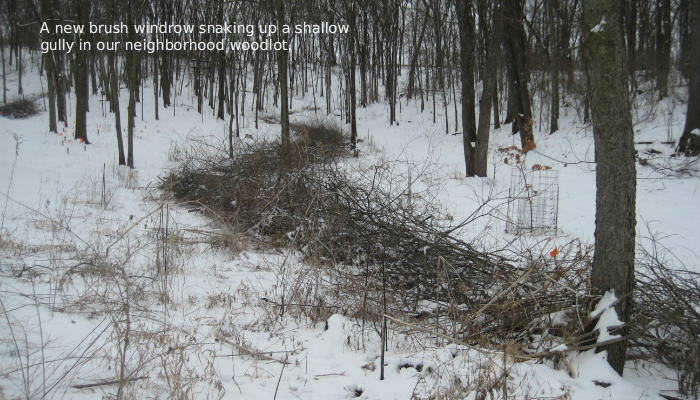Honeysuckle Brush for Erosion Control and Habitat

Many of today’s woodlots were originally left in trees because the parcel was too steep to plow, and most were subsequently overgrazed. Consequently, many today have a gully forming along the drainageway. Also today, many are overgrown with honeysuckle brush. But together this creates an opportunity, because you can cut the brush and use it to control the erosion.
Where you have a small problem (a gully a few feet deep and a 5 or 10 acre watershed covered with grass and trees) you can simply toss the brush into the gully and pack it down by hand, and it will jam into the sides of the gully and not float away during the next downpour. If it’s a larger gully (3 or 4 feet deep and a larger watershed, perhaps 15 or 20 non-eroding acres) you need to anchor the brush, at least at intervals, to prevent it from moving in floodwaters. Beyond that (a large watershed and/or cropland, rooftops, or parking lots producing flashy runoff) you need more serious interventions, which are beyond the scope of today’s blog.
These serpentine brush piles also become instant habitat. The one in the attached photo is only a few months old and has had little birds sheltering in it all winter. When I stepped up on a log to take the photo, a dark brown mink squirted out from under the log and dove headlong into the brush. Two minutes later a rabbit darted out 25 yards away, spooked by the approaching mink. A few minutes more and another rabbit appeared, about 100 yards away. Still more minutes and the mink – very visible against the snow – came out the far end of the windrow and raced off through the woods.
A few days later, I revisited the site and a very black mink hustled into the gully brush. Whether it was the same mink, just wetter and darker, or a mate to the first, I do not know. But this is their breeding season, during which they briefly tolerate each other, before returning to their solitary lives.
My game plan is to also use the brush windrow as a trellis to plant uncommon native vines, perhaps pipevine, moonseed, or trumpet honeysuckle. (Moonseed has toxic berries that look like grapes, so it’s probably not a good idea if unwary children will be there.)
So if you have a woodlot with brush or tree trimmings to remove, look for some way to utilize them as a resource for better management.


